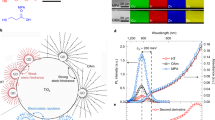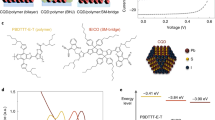Abstract
Quantum dot (QD) photovoltaic devices are attractive for their low-cost synthesis, tunable band gap and potentially high power conversion efficiency (PCE). However, the experimentally achieved efficiency to date remains far from ideal. Here, we report an in-situ fabrication and investigation of single TiO2-nanowire/CdSe-QD heterojunction solar cell (QDHSC) using a custom-designed photoelectric transmission electron microscope (TEM) holder. A mobile counter electrode is used to precisely tune the interface area for in situ photoelectrical measurements, which reveals a strong interface area dependent PCE. Theoretical simulations show that the simplified single nanowire solar cell structure can minimize the interface area and associated charge scattering to enable an efficient charge collection. Additionally, the optical antenna effect of nanowire-based QDHSCs can further enhance the absorption and boost the PCE. This study establishes a robust ‘nanolab’ platform in a TEM for in situ photoelectrical studies and provides valuable insight into the interfacial effects in nanoscale solar cells.
This is a preview of subscription content, access via your institution
Access options
Access Nature and 54 other Nature Portfolio journals
Get Nature+, our best-value online-access subscription
$29.99 / 30 days
cancel any time
Subscribe to this journal
Receive 12 print issues and online access
$259.00 per year
only $21.58 per issue
Buy this article
- Purchase on Springer Link
- Instant access to full article PDF
Prices may be subject to local taxes which are calculated during checkout





Similar content being viewed by others
Data availability
The data that support the plots within this paper and other findings of this study are available from the corresponding author upon reasonable request.
References
Kamat, P. V. Quantum dot solar cells. Semiconductor nanocrystals as light harvesters. J. Phys. Chem. C 112, 18737–18753 (2008).
Tian, J. et al. Constructing ZnO nanorod array photoelectrodes for highly efficient quantum dot sensitized solar cells. J. Mater. Chem. A 1, 6770–6775 (2013).
Sambur, J. B., Novet, T. & Parkinson, B. A. Multiple exciton collection in a sensitized photovoltaic system. Science 330, 63–66 (2010).
Semonin, O. E. et al. Peak external photocurrent quantum efficiency exceeding 100% via MEG in a quantum dot solar cell. Science 334, 1530–1533 (2011).
Hanna, M. C. & Nozik, A. J. Solar conversion efficiency of photovoltaic and photoelectrolysis cells with carrier multiplication absorbers. J. Appl. Phys. 100, 074510 (2006).
Shockley, W. & Queisser, H. J. Detailed balance limit of efficiency of p–n junction solar cells. J. Appl. Phys. 32, 510–519 (1961).
Du, J. et al. Zn–Cu–In–Se quantum dot solar cells with a certified power conversion efficiency of 11.6%. J. Am. Chem. Soc. 138, 4201–4209 (2016).
Shen, Q., Kobayashi, J., Diguna, L. J. & Toyoda, T. Effect of ZnS coating on the photovoltaic properties of CdSe quantum dot-sensitized solar cells. J. Appl. Phys. 103, 084304 (2008).
Fan, S.-Q. et al. Highly efficient CdSe quantum-dot-sensitized TiO2 photoelectrodes for solar cell applications. Electrochem. Commun. 11, 1337–1339 (2009).
Lee, Y.-L. & Lo, Y.-S. Highly efficient quantum-dot-sensitized solar cell based on co-sensitization of CdS/CdSe. Adv. Funct. Mater. 19, 604–609 (2009).
Lee, H. et al. Efficient CdSe quantum dot-sensitized solar cells prepared by an improved successive ionic layer adsorption and reaction process. Nano Lett. 9, 4221–4227 (2009).
Li, L. et al. Highly efficient CdS quantum dot-sensitized solar cells based on a modified polysulfide electrolyte. J. Am. Chem. Soc. 133, 8458–8460 (2011).
Jin-nouchi, Y., Naya, S. I. & Tada, H. Quantum-dot-sensitized solar cell using a photoanode prepared by in situ photodeposition of CdS on nanocrystalline TiO2 films. J. Phys. Chem. C 114, 16837–16842 (2010).
Sun, Z. et al. Continually adjustable oriented 1D TiO2 nanostructure arrays with controlled growth of morphology and their application in dye-sensitized solar cells. CrystEngComm 14, 5472–5478 (2012).
Sun, Z., Kim, J. H., Zhao, Y., Attard, D. & Dou, S. X. Morphology-controllable 1D–3D nanostructured TiO2 bilayer photoanodes for dye-sensitized solar cells. Chem. Commun. 49, 966–968 (2013).
Chen, X. Y., Ling, T. & Du, X. W. Low-temperature synthesis of ZnO/CdS hierarchical nanostructure for photovoltaic application. Nanoscale 4, 5602–5607 (2012).
Sudhagar, P. et al. High open circuit voltage quantum dot sensitized solar cells manufactured with ZnO nanowire arrays and Si/ZnO branched hierarchical structures. J. Phys. Chem. Lett. 2, 1984–1990 (2011).
Zhu, Z., Qiu, J., Yan, K. & Yang, S. Building high-efficiency CdS/CdSe-sensitized solar cells with a hierarchically branched double-layer architecture. ACS Appl. Mater. Interfaces 5, 4000–4005 (2013).
Zhao, K. et al. Boosting power conversion efficiencies of quantum-dot-sensitized solar cells beyond 8% by recombination control. J. Am. Chem. Soc. 137, 5602–5609 (2015).
Huang, J. Y. et al. In situ observation of the electrochemical lithiation of a single SnO2 nanowire electrode. Science 330, 1515–1520 (2010).
Xu, F. et al. Visualization of lithium-ion transport and phase evolution within and between manganese oxide nanorods. Nat. Commun. 8, 15400 (2017).
Liu, Q. et al. Real-time observation on dynamic growth/dissolution of conductive filaments in oxide-electrolyte-based ReRAM. Adv. Mater. 24, 1844–1849 (2012).
Miller, B. K. & Crozier, P. A. System for in situ UV–visible illumination of environmental transmission electron microscopy samples. Microsc. Microanal. 19, 461–469 (2013).
Cavalca, F. et al. Light-induced reduction of cuprous oxide in an environmental transmission electron microscope. Chem. Cat. Chem. 5, 2667–2672 (2013).
Lan, X., Masala, S. & Sargent, E. H. Charge-extraction strategies for colloidal quantum dot photovoltaics. Nat. Mater. 13, 233 (2014).
Tian, B. et al. Coaxial silicon nanowires as solar cells and nanoelectronic power sources. Nature 449, 885–889 (2007).
Tang, J., Huo, Z., Brittman, S., Gao, H. & Yang, P. Solution-processed core–shell nanowires for efficient photovoltaic cells. Nat. Nanotechnol. 6, 568–572 (2011).
Cao, G. et al. Design of μc-Si:H/a-Si:H coaxial tandem single-nanowire solar cells considering photocurrent matching. Opt. Express 22, A1761–A1767 (2014).
Kempa, T. J., Day, R. W., Kim, S.-K., Park, H.-G. & Lieber, C. M. Semiconductor nanowires: a platform for exploring limits and concepts for nano-enabled solar cells. Energ. Environ. Sci. 6, 719–733 (2013).
Nepal, J., Sadegh Mottaghian, S., Biesecker, M. & Farrokh Baroughi, M. Modeling of trap assisted interfacial charge transfer in dye sensitized solar cells. Appl. Phys. Lett. 102, 203503 (2013).
Zhang, S., Yang, X., Numata, Y. & Han, L. Highly efficient dye-sensitized solar cells: progress and future challenges. Energ. Environ. Sci. 6, 1443–1464 (2013).
Ni, M., Leung, M. K. H., Leung, D. Y. C. & Sumathy, K. Theoretical modeling of TiO2/TCO interfacial effect on dye-sensitized solar cell performance. Sol. Energy Mater. Sol. Cells 90, 2000–2009 (2006).
De Jongh, P. E. & Vanmaekelbergh, D. Trap-limited electronic transport in assemblies of nanometer-size TiO2 particles. Phys. Rev. Lett. 77, 3427–3430 (1996).
Van de Lagemaat, J. & Frank, A. J. Effect of the surface-state distribution on electron transport in dye-sensitized TiO2 solar cells: nonlinear electron-transport kinetics. J. Phys. Chem. B 104, 4292–4294 (2000).
Tian, J. & Cao, G. Control of nanostructures and interfaces of metal oxide semiconductors for quantum dots sensitized solar cells. J. Phys. Chem. Lett. 6, 1859–1869 (2015).
Abass, A., Shen, H., Bienstman, P. & Maes, B. Angle insensitive enhancement of organic solar cells using metallic gratings. J. Appl. Phys. 109, 023111 (2011).
Pan, Z. et al. Near infrared absorption of CdSexTe1–x alloyed quantum dot sensitized solar cells with more than 6% efficiency and high stability. ACS Nano 7, 5215–5222 (2013).
Acknowledgements
This research was supported by National Key Research and Development Program of China (2017YFA0204800), the Natural National Science Foundation of China (Grant nos. 11327901, 11525415, 51420105003, 61106055, 11774051, 61574034 and 61601116), the National Basic Research Program of China (2015CB352106), the Fundamental Research Funds for the Central Universities (2242018K41020). Z.S. appreciates the financial support from the Australian Research Council (ARC) through an ARC Future Fellowship project (FT180100387) and a Discovery Project (DP160102627).
Author information
Authors and Affiliations
Contributions
H.D., F.X., Z.Z. and L.S. conceived and designed the experiments. H.D. performed the experiments. H.D., Z.S., L.S., Z.Z. and X.D. analysed the data and constructed the paper. Y.Z. performed the finite‐difference time‐domain simulation. L.S. contributed materials and analysis tools. H.D. and Z.S. co-wrote the paper with all the authors contributing to the discussion and preparation of the manuscript.
Corresponding authors
Ethics declarations
Competing interests
The authors declare no competing interests.
Additional information
Peer review information: Nature Nanotechnology thanks Giorgio Divitini and the other, anonymous, reviewer(s) for their contribution to the peer review of this work.
Publisher’s note: Springer Nature remains neutral with regard to jurisdictional claims in published maps and institutional affiliations.
Supplementary information
Supplementary Information
Supplementary Figs. 1–36 and refs. 1–11.
Rights and permissions
About this article
Cite this article
Dong, H., Xu, F., Sun, Z. et al. In situ interface engineering for probing the limit of quantum dot photovoltaic devices. Nat. Nanotechnol. 14, 950–956 (2019). https://doi.org/10.1038/s41565-019-0526-7
Received:
Accepted:
Published:
Issue Date:
DOI: https://doi.org/10.1038/s41565-019-0526-7
This article is cited by
-
CuFe2O4/MoS2 Mixed-Dimensional Heterostructures with Improved Gas Sensing Response
Nanoscale Research Letters (2020)



